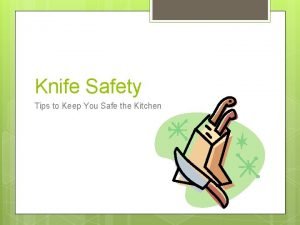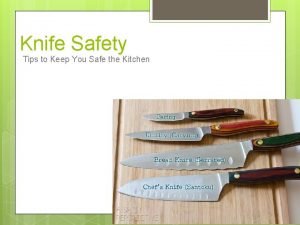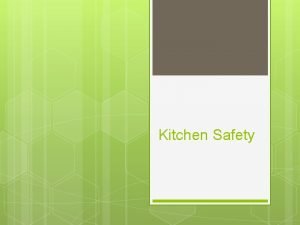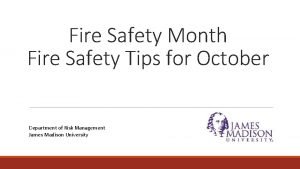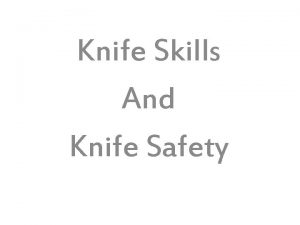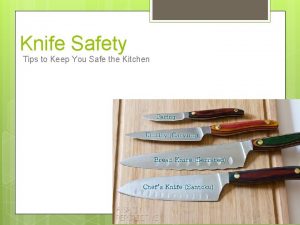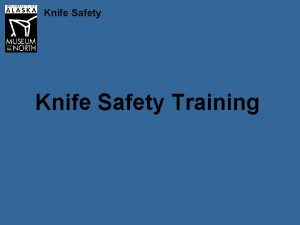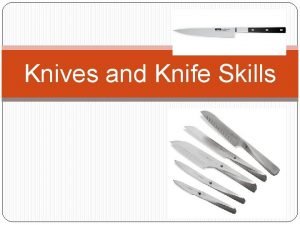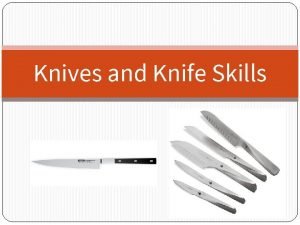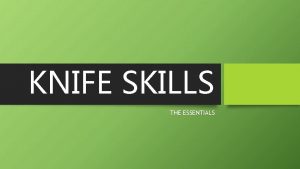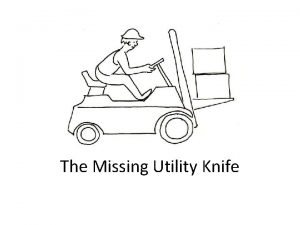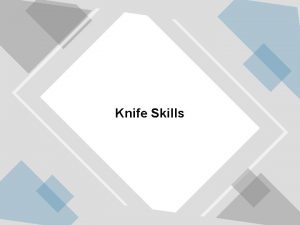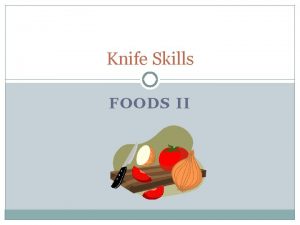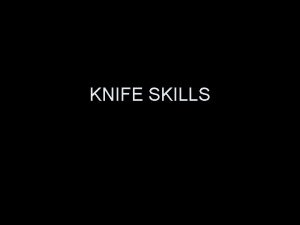Knife Safety Tips to Keep You Safe the
















- Slides: 16

Knife Safety Tips to Keep You Safe the Kitchen

Safety Tips • Always use the correct knife for the task. • Never use a knife to perform inappropriate tasks, like opening a can. • Always use a sharp knife. More accidents happen when using a dull knife because it may require more force. How to sharpen your knives: http: //www. youtube. com/watch? v=syvvxx 3 e. Gp. I&feat ure=related

The Three Essential Kitchen Knives • • • Chef’s knife Paring knife Serrated bread knife

Chef’s Knife • Largest knife in the kitchen. • Usually 8 – 10” long. • Should feel comfortable and balanced in your hand. • Should have a full tang: the blade should go completely through the handle to promote long wear and stability. • Use to cut, chop or mince food with a cutting board. For example,

Paring Knife • • • Small blade – 2 ½ - 4” long Mainly used for peeling fruits and vegetables Also used to create garnishes

Serrated Bread Knife • Must be very sharp to slice bread easily. • Blade must be at least 7” long, but preferably 9” to adequately slice bread – the longer the blade, the cleaner the slice. • Also effective for cutting tomatoes.

How to Hold the Knife Hold the knife properly to have control of the knife. Tips: • Demonstration of how to hold a knife. http: //www. youtube. com/watch? v=6 EVWhtf. Rw 2 E

Using the Knife to Chop • Use your non-dominant hand (guiding hand) in a “claw” to stabilize the food to be cut. • The “claw” prevents fingers from being cut. • Demo on how to hold your other hands safely: http: //www. youtube. com/watch? v=s. Lu. U 390 MX 9 M&f eature=related • As you chop, use the dominant hand to rock the knife without lifting it. • The guiding hand (using “the claw”) will move the food toward the knife as you chop.

Incorrect Knife Usage • Notice the way each hand is positioned. • The knife is held improperly. • The guiding hand is not in “the claw” position. • The knife has left the board.

Tips to cut: • Slowly and with care. • Away from the body. • Dry hands to prevent slippage • Avoid distractions • Pay attention • First chop fruits and vegetables in half to create a flat surface. The food won’t roll under the knife.

Cutting Board Tips • Use a clean plastic cutting board. • Glass, ceramic and marble cutting surfaces dull knives. • Placing a flattened damp towel under the board to prevent slipping.

Carrying Knives • • • Hold by the handle, with the point of the blade straight down at your side. The sharp edge is facing behind you. Don’t try to catch a falling knife. Step away and let it fall. When passing a knife to someone, lay the knife down on the work surface or pass it carefully holding the dull side of the blade with the handle facing toward the other person.

Cutting Board Safety & Sanitation • Always use a clean and sanitized cutting board. • Sanitize the meat cutting board with bleach solution.

Cleaning Knives • • Always hand wash, sanitize, and dry knives before putting them away. When washing knives, keep separate from other dishes. Carefully dry knives from the dull side. http: //www. youtube. com/watch? v=om. ZCt 6 g. ES 9 w&feature=related

Storing Knives Always store knives separately using a • knife block • specially designed blocks for kitchen drawers • magnetic strip Careful storage will help to keep the blade sharp.

Resources • http: //busycooks. about. com/od/howtocook/a/kitchenkn • • • ife_2. htm http: //www. foodservicewarehouse. com/restaurantequipment-supply-marketing-articles/product-safetypublic-health/knife-safety-in-the-commercial-kitchen/c 28189. aspx http: //housewares. about. com/od/cutleryknives/f/bread knives. htm http: //www. sheknows. com/food-andrecipes/articles/815875/safe-knife-skills-in-the-kitchen 1 http: //www. youtube. com/watch? v=om. ZCt 6 g. ES 9 w&fea ture=related http: //www. youtube. com/watch? v=s. Lu. U 390 MX 9 M&fe ature=related
 Kitchen knife safety tips
Kitchen knife safety tips Knife safety in the workplace
Knife safety in the workplace Keep it secret keep it safe
Keep it secret keep it safe Knife safety poster
Knife safety poster Law pub quiz questions
Law pub quiz questions Keep satisfied manage closely monitor keep informed
Keep satisfied manage closely monitor keep informed Stakeholders mapping
Stakeholders mapping Psia unit
Psia unit Environmentally safe refrigerant service tips & techniques
Environmentally safe refrigerant service tips & techniques Ethos examples
Ethos examples Safe feed safe food
Safe feed safe food Safe people safe places
Safe people safe places One direction one thing
One direction one thing October safety tips
October safety tips Sar checklist
Sar checklist Animal lab safety rules
Animal lab safety rules Mobile equipment safety policy
Mobile equipment safety policy
